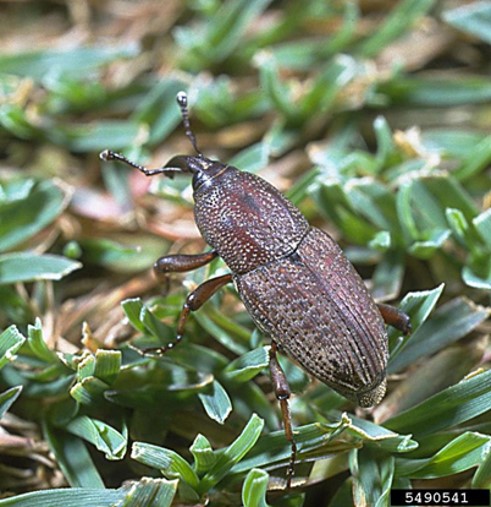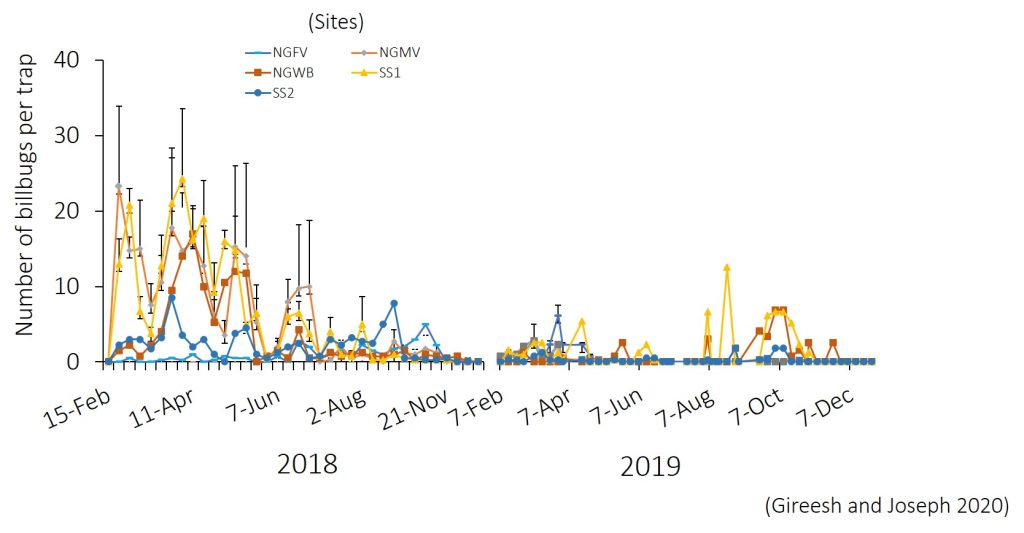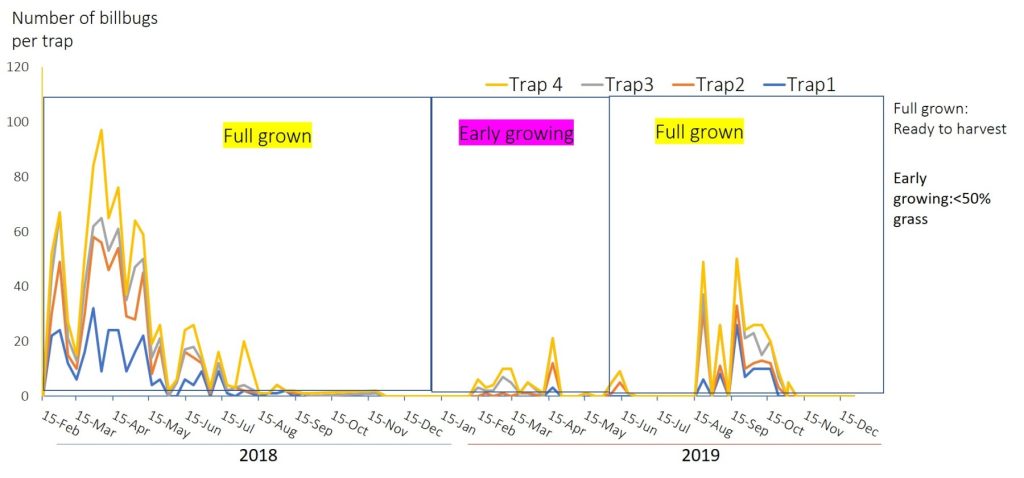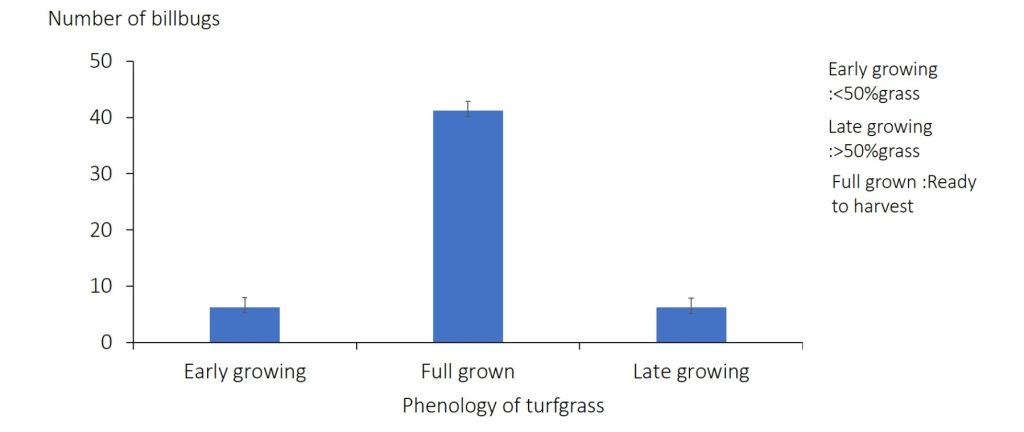The billbug pest complex (Sphenophorus spp.) has increased in importance in turfgrass systems throughout the U.S. in recent years, causing significant losses to sod farms, golf courses, and the landscape care industry, maintaining residential, commercial, and public lawns. The hunting billbug, Sphenophorus venatus vestitus Chittenden, is the most destructive species in warm-season grasses. Adult female billbugs oviposit eggs inside the stolons (stem) of turfgrass. The emerging first instars feed within the internodal space of the stolons. When they molt into second instars, they break out of the stolons because of the inadequate space within the stolons and drop into the soil. After that, they molt through four more instars before becoming pupae. The pupal stage occurs in the soil.

Knowledge of seasonal occurrence, abundance, and species diversity is critical to developing IPM strategies, such as sampling plans or management tactics, for billbugs in sod farms. To date, management approaches have been adopted from previous research on golf courses in North and South Carolina and Florida. Hunting billbugs undergo two generations per year in North Carolina, whereas there are up to six generations per year in Florida. The variability in billbug voltinism underscores the need to understand regional billbug phenology in turfgrass because the number of generations will dictate the number of insecticide applications needed. Most previous billbug research has been conducted on golf courses. Billbug management approaches on golf courses may not directly apply to sod farms because management options and goals, such as fertilization, irrigation, and plant protection practices, of the two systems vary distinctly. Turfgrass on golf courses is not harvested and sold; it is fully grown, and emphasis is placed on maintenance. Turfgrass in sod farms is harvested and sold, and then the grass is grown from sprigs or rhizomes from the same cut patch within a short time frame. Thus, it is important to determine the occurrence and seasonal abundance of billbugs relative to the growth stages of turfgrass in sod farms.

The results show that the hunting billbug, S. venatus vestitus, is the most common species collected from sod farms in Georgia (Figs. 1 and 2). This result is consistent with billbug captures in the Carolinas and Florida, where S. venatus vestitus was also the most abundant species in warm-season turfgrass. Other minor species captured in the current study include S. inaequalis and S. cariosis, found on golf courses in Florida and South Carolina, although S. cariosis was not reported from golf courses in North Carolina.
The data show that billbugs were abundant in sod farms when the turfgrass was fully grown or ready to harvest (Figs. 3 and 4). Unlike in golf courses or residential or public lawns, turfgrass in sod farms is continuously grown, cut, and sold throughout the year. Within a sod farm, sod producers maintain turfgrass at various stages in several fields to meet the demand year-round. Hunting billbugs undergo two generations per year in North Carolina and up to six generations per year in Florida. The number of hunting billbug generations in Georgia can vary between two and six, as sod is produced in approximately 61 counties across the state. This also suggests that the longer the turfgrass stays in the ground, the more vulnerable it is to the constant influx and colonization of billbugs, resulting in a high population buildup. Although billbugs are found on both zoysiagrass and bermudagrass, zoysiagrass is slowly growing and takes approximately six more months to prepare for harvest in central Georgia. This longer time frame not only exposes zoysiagrass to within-field accumulation and invasion of several overlapping generations of billbugs but also magnifies the damage potential of billbugs to zoysiagrass because this species does not recover well once damaged by adult and larval billbugs. This was evident in the data, as the number of billbugs captured was higher in the fully grown turfgrass than grass in the early or late developmental stages.
Billbug density was greater on the Z. matrella cultivar ‘Zeon’ and hybrid ‘Emerald’ than on the Z. japonica cultivars ‘El Toro’ and ‘Zenith’. Previous studies show that zoysiagrass cultivars such as ‘Emerald’, ‘Royal’, ‘Zeon’, and ‘Zorro’ are resistant to the hunting billbug, whereas ‘Zenith’ and ‘El Toro’ are susceptible to this pest. The exact reason for this is not clear. Previous data also showed that Z. matrella cultivars were less susceptible to hunting billbug damage than are Z. japonica cultivars. In the current study, the sex ratio of male to female hunting billbugs from all five sod farm sites was approximately the same, consistent with a previous study.


The results show that S. venatus vestitus is the dominant billbug species in Georgian sod farms. Other minor species of billbugs found in the traps included S. inaequalis and S. cariosis. The data showed that billbugs were abundant when the turfgrass was fully grown or ready to harvest. This suggests that the management of billbugs in sod farms should not be based on billbug phenology data described from golf courses in neighboring southern states (where sequential spikes of billbug abundance were observed), which are used to time insecticide application for specific life stages of billbugs. The data suggest that a field-by-field management strategy needs to be developed to reduce population surges in slow-growing zoysiagrass. More studies are necessary to understand the risk of incidence and abundance of billbugs in a given sod field; factors such as when turfgrass was previously harvested, the turfgrass growth stage, and the temporal exposure windows to billbug populations within and adjacent to turfgrass fields in sod farms should be studied. Clearly, current integrated pest management plans, including the use of insecticides, timing of applications, turfgrass stage, and harvest time, need to be revisited to improve billbug control in sod farms.
For detailed reading, please refer to the full article published in a peer-reviewed Journal (pdf below).
Gireesh, M., and S. V. Joseph. 2020. Seasonal occurrence and abundance of billbugs (Coleoptera: Curculionidae) in Georgia sod farms. J. Econ. Entomol. 113: 2319–2327. doi: 10.1093/jee/toaa133.